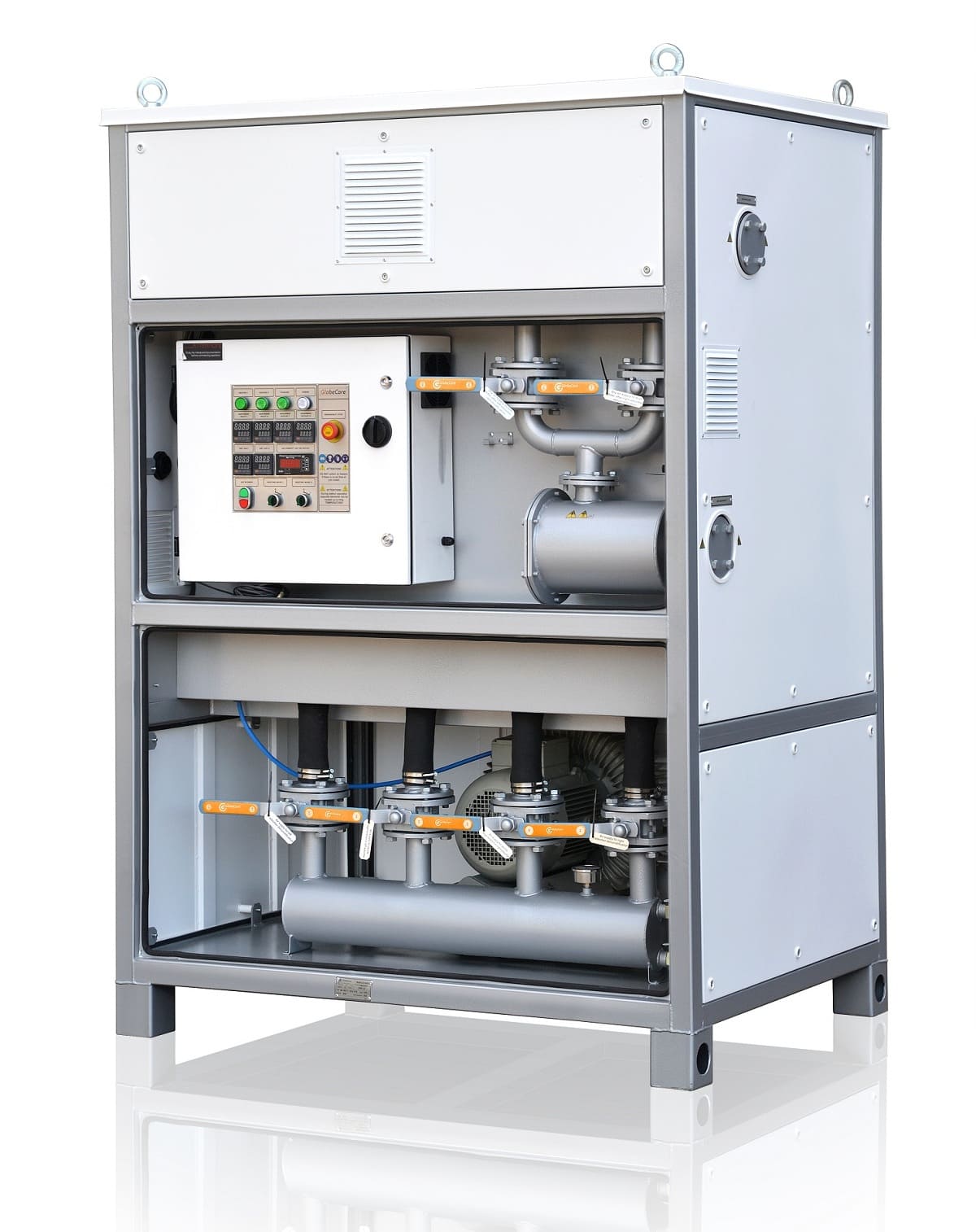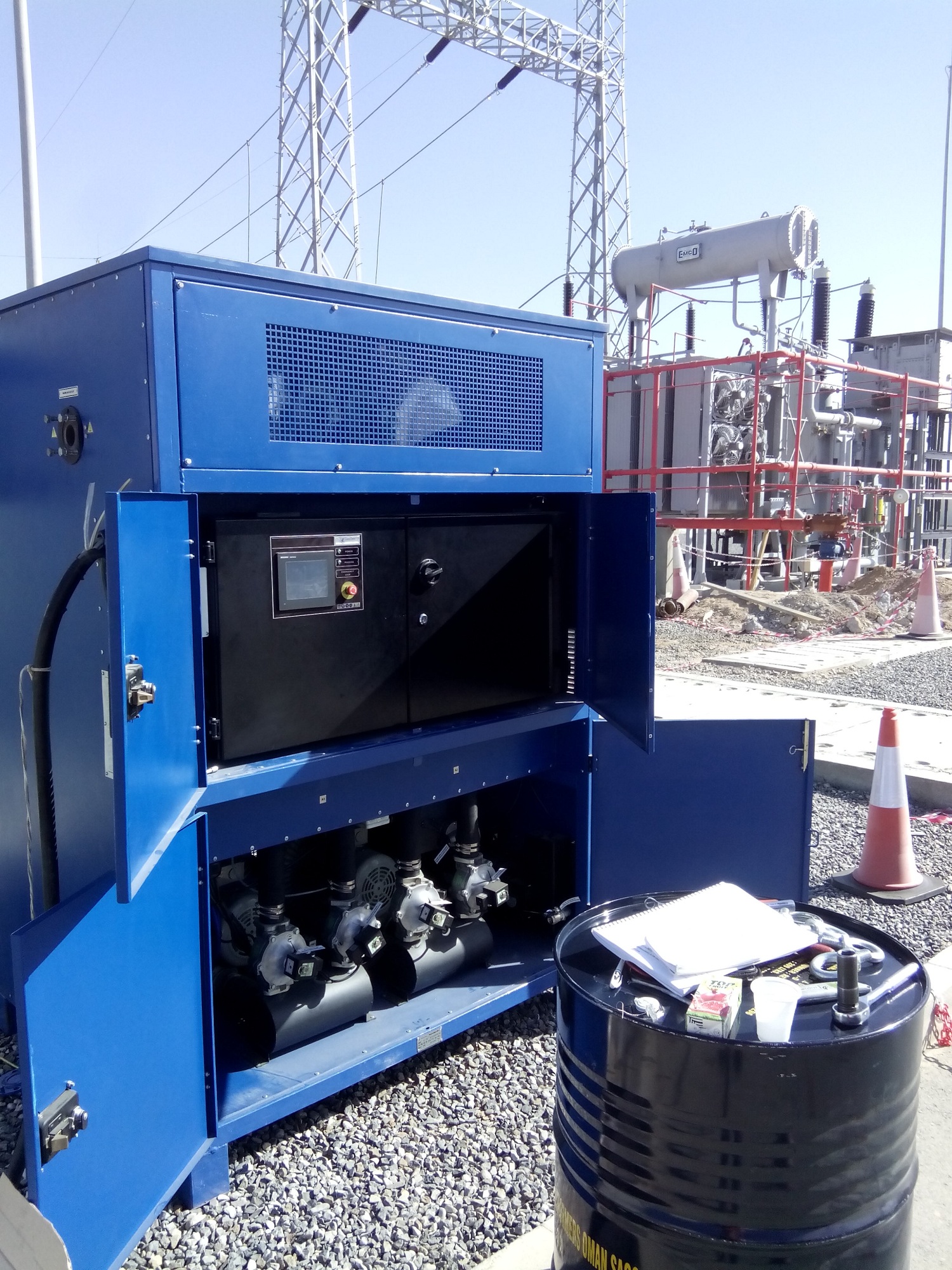Mojave Heat (Sukhovey): Hot Air Dryer Unit

Mojave
-
Advantages
- protect the insulation system from moisture;
- carry out depressurization in several stages, with a complete assembly of transformer;
- prevent heating of transformer.
The Mojave Heat (Sukhovey) hot air dryer unit is designed for drying1Drying is a mass transfer process consisting of the removal of water or another solvent by evaporation from a solid, semi-solid or liquid. of air and removal of solid particles from atmospheric air, as well as for sorbent drying. Dry purified air can be used for purging of transformer2A transformer is a static electrical device that transfers electrical energy between two or more circuits. tanks and electrical equipment during installation, service or repairs to prevent dielectric insulation from accumulating moisture while the core is exposed.
The unit is designed as a metal body separated into two compartments. The unit operates as two independent adsorbers3Adsorber is an apparatus for absorption by a surface layer of a solid, called an adsorbent, of dissolved or gaseous substances that is not accompanied by a chemical reaction., filled with synthetic zeolite4Zeolites are microporous, aluminosilicate minerals commonly used as commercial adsorbents and catalysts., and a dust filter to remove solid contaminants from the air.
|
Parameter |
Value | |
| Mojave Heat 0.7 | Mojave Heat 4 | |
| Dry air capacity, m3 /minute, min / cubic yard | 1.7/2.223 | 2.5/3.27 |
| Dry air dew point, °С/°F, max | -50/-58 | -50/-58 |
| Dry air pressure, MPa/bar, max | 0.018/0.18 | 0.025/0.25 |
| Max dry air temperature, °С/°F | 90±15/194±27 | 90±15/194±27 |
| Adsorbent load, kg/lbs, max | 190/419.9 | 190/419.9 |
| Number of adsorbers. | 1 | 2 |
| Zeolite regeneration temperature, °С/°F, max | 430/806 | 430/806 |
| Air heater power, kW, Max | 24 | 24 |
| Nominal power consumption, kW max | ||
| Air drying (normal operating mode) | 1 | 5.5 |
| Sorbent regeneration in one adsorber | 25 | 30 |
| Sorbent regeneration in two adsorbers | – | 55 |
| Nominal power voltage at 50Hz/ 60Hz, V (Electric power can be fully customized on request ) | 380 | 380 |
| Output air temperature for regeneration of external adsorbents, °С/°F, max | 430/806 | 430/806 |
| Duration of adsorbent regeneration, hours | 4 | 2-4 |
| Dry air filtration fineness, micron | 5 | 5 |
| Dimensions, mm/in, max: | ||
| • length | 1350 (53) | 1500 (59) |
| • width | 800 (32) | 1120 (44) |
| • height | 1700 (67) | 2120 (83) |
| Weight, kg/lbs, max | 550 (1210) | 1050 (2315) |
Aplication :
- protect the insulation system from moisture;
- carry out depressurization in several stages, with a complete assembly of transformer;
- prevent heating of transformer.
Aplication :
GlobeCore Mojave Heat unit can be used for:
- purging of transformer tanks with dry hot air when depressurizing the transformer to protect the windings insulation against wetness;
- reconditioning of moisture-saturated zeolite;
- drying of communication cables;
- drying of fruit, vegetables, herbs, spices, meat and fish;
- drying of medicinal products and biological materials where moisture control is important;
- keeping the humidity low in the processes of producing and testing the electronic components, such as semiconductors;
- efficient drying of materials in production of paper and textiles which contributes to upgrading the quality of products and reducing the production time;
- drying of chemical substances, improvement of production and storage processes;
- processing of grain and farm products during their storage;
- drying of wood prior to further processing which reduces the risk of warping and upgrades the quality of end products;
- drying of indoor spaces, buildings, and equipment after flooding or water leakage;
- drying of components in the aerospace industry to ensure the required storage conditions;
- drying and maintaining the optimal condition of military equipment, military apparel, and other materials;
- drying of waste before its recycling or neutralization which can decrease the volume and facilitate processing;
- drying of mining samples before analysis;
- drying of biomass before processing it with conversion into biofuel which improves the process efficiency;
- drying and treatment of contaminated or soaked soils to improve their environmental performance;
- drying of recycled plastics prior to further processing and molding;
- creation of optimal conditions for cultivation of plants, particularly in cold weather or for specialized experiments;
- drying of bricks, concrete products, and plasterboard to ensure their strength and durability;
- drying of ceramic products before firing;
- drying the interior spaces of transportation means, including ships, planes, and motor vehicles, to prevent corrosion and ensure passenger comfort;
- drying of battery components before assembling to ensure their reliability and durability;
- drying of ingredients or finished animal feed to ensure their long-term storage quality and nutritional value;
- drying of tobacco leaves before fermenting and processing which has an effect on the taste and quality of end product;
- drying of coal briquettes or coal powder before use or packaging;
- drying of leather after its working and dyeing to achieve optimal quality and softness;
- drying and processing of sports equipment, such as skiing or camping gear, to increase its durability and comfort of use;
- drying of paint and coatings on motor vehicles during the production process to ensure a high-quality finish;
- drying and preparation of fibers, such as fiberglass or carbon fibers, before using them in composites to increase the strength and reduce the weight of products;
- drying of materials for production of solar panels or biomass for bioenergy to improve their efficiency and durability;
- drying of ceramic and porcelain dishware before glazing and firing;
- use of dry hot air to remove the remaining oil, grease, paint, or other contaminants from metal surfaces;
- drying of coatings on furniture, finishing materials, or building components to ensure their durability and esthetic appearance;
- drying of fragrances, dyes, and other ingredients of scented candles and soaps before adding them to the base mass for homogenous composition and stability of the product;
- use of dry hot air for additional disinfection of medical tools and devices after conventional sterilization;
- drying of fabrics and materials used in production of sportswear to improve their water-repellent and breathable properties;
- generating special effects with the use of dry hot air, for example, simulating a desert or tropical climate in confined spaces;
- using dry hot air to remove moisture from the wood before applying the protective coatings which extends the service life and reduces the risk of rotting and pest attack;
- light-duty drying of grapes and other fruits before fermentation to ensure concentrated flavors and aromas;
- drying the ingredients of mineral fertilizers before mixing;
- drying of paper, cardboard, and other materials before processing them with conversion into packing to increase strength and durability;
- drying of natural ingredients prior to their use in cleaning product formulas for improved efficiency and ensured environmental safety;
- drying of materials and constituents, such as clay, plastics, or wood, before processing and decorating;
- quick creation of dry and warm environment in theme parks, at exhibitions, or in filming sets;
- drying of paints and glues on children’s toys to ensure their safety and durability;
- drying and preservation of archeological finds and artifacts for maintenance and further study;
- creating an optimal climate in libraries and archive facilities which allows protecting the paper against moisture and mold;
- drying of spices and herbs at low temperatures to preserve their aroma and properties for upgraded quality of product;
- drying of electrical insulating materials to ensure high insulating properties.
Aplication :
Aplication :
Equipment configurations that are not included in this configurator can be implemented via a separate request to [email protected].
Aplication :
Aplication :




